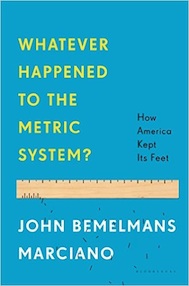Jay M. Pasachoff
I expected this book to describe the 1999 loss of a NASA spacecraft during its attempted Mars landing because of a mixup of “customary” measures and metric measures. But I did not expect such contemporary matters to be relegated to a final chapter, with fascinating centuries of history making up the bulk of this interesting book.
The history of measurement is far more wide ranging than is implied by the unfortunately narrow title; the book discusses not only weights and measures but also, for example, coinage, calendars, and simplified spelling (such as that sponsored by the Dewey Decimal System’s Melville Dewey, pointed out as perhaps better written Melvil Dui). The first 13 of the 16 chapters, cutely labeled 1/16 to 13/16, deal with matters from long ago. We learn about the involvement in standards of measurement of Jefferson, Lafayette, Gouverneur Morris, John Quincy Adams, Lavoisier, and their influence.
From time to time, incidents from the past are echoed in the present. At the time of the French revolution, Jacques Turgot didn’t want to add to their national debt, an argument still going on, therefore opposing that country’s supporting our American revolutionaries. In 1781, Jefferson was investigated for his supposed neglect of Virginia’s militia, for example, preventing his joining Adams and Franklin in Paris to negotiate the end of the Revolutionary War. He was exonerated though, a difference from Virginia’s current governor. I read in today’s New York Times about the exigencies of New York City’s real-estate market, and learned in the book of the real-estate difficulties that Jefferson had when he traveled to meet Washington in New York upon being appointed the first Secretary of State. Marciano describes how a bill passed Congress in 1896 to take the U.S. metric but was withdrawn within minutes for fear that “angry farmers bewildered by having to chuck their bushels for liters would show their wrath in the upcoming election,” an event that reminded me of this week’s announcement of the postponement of a presidential order relevant to immigration reform until after the coming election.
Did you know that gold is measured in one type of pound (troy) and feathers in another (avoirdupois), so that a pound of feathers is 22% heavier than a pound of gold? Did you know that an inch and a fathom are derived from measurements of the human body? I didn’t know that Jefferson tried to lay out the western territory in terms of degrees of latitude and longitude, including what he called Michigania and Illinoia. I had forgotten that George Orwell, in 1984, wrote that Big Brother’s regime had imposed the metric system.
When the author described how “the 1830s saw the opening of America’s first permanent observatories,” I wish he had mentioned ours, at Williams College, the nation’s oldest extant observatory, by name, though he accurately described that these first observatories “tended to be at colleges and driven by the support of a single individual.” He described John Quincy Adams’s interest in such “lighthouses of the sky.” As for errors, I noticed very few, such as an extra “e” on “Systéme International” in the text though not in the appendix, and a statement that George Washington’s birth year was changed from 1731 to 1732 with the change of calendar, while I reproduce an image from Mt. Vernon in my survey textbook The Cosmos that his family bible actually shows his birth date as “February 11, 1731/2.”
We learn about such matters as William Herschel’s mid-19th-century opposition to the metric system and the cockeyed ideas of the Astronomer Royal for Scotland, Charles Piazzi Smyth, that the Great Pyramid in Giza used a sacred inch also used by Noah to build his ark and that 365.25 divine cubits measured the Pyramid’s perimeter.
The name John Bemelmans Marciano made me think of little Madeline, and indeed two of his previous books are Madeline at the White House and Madeline and the Cats of Rome, confirming his lineage.
I can recommend this book to all readers.
Astronomer and author Jay M. Pasachoff is the director of Hopkins Observatory and Field Memorial Professor of Astronomy at Williams College. He is a Visitor in the Planetary Sciences Department of Caltech. Williams College is home to the Gamma of Massachusetts Chapter of Phi Beta Kappa.




